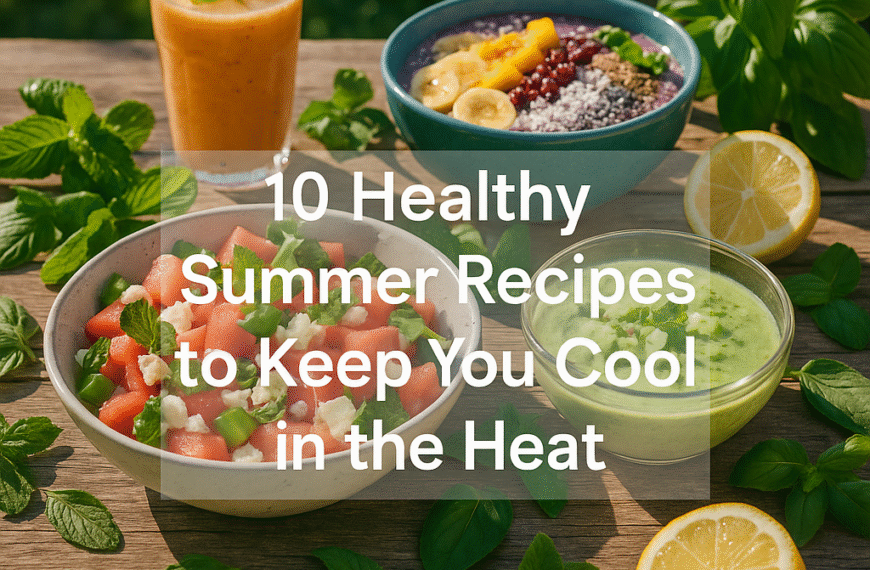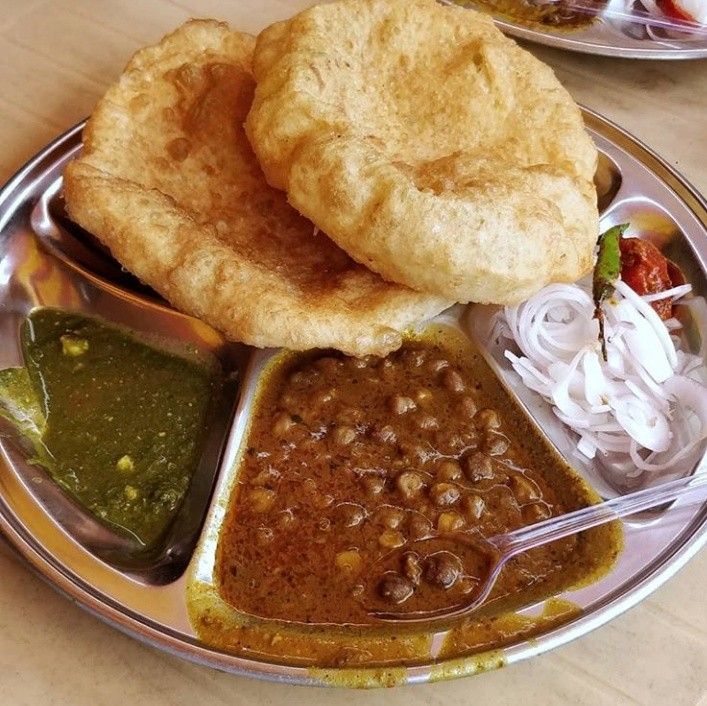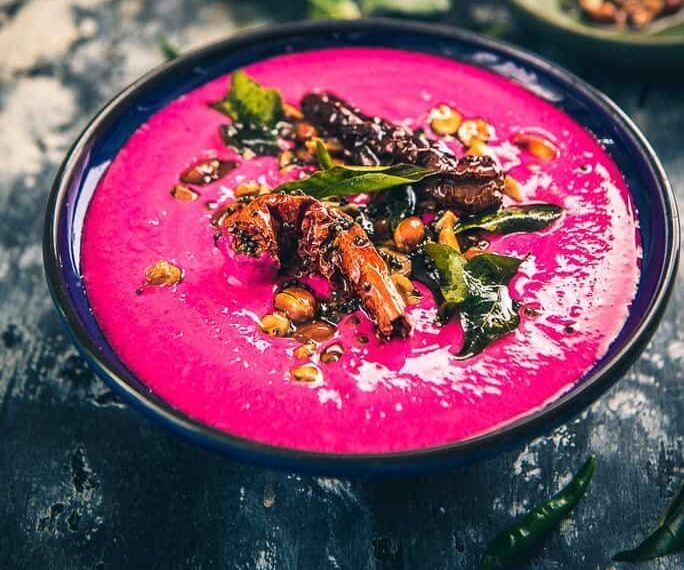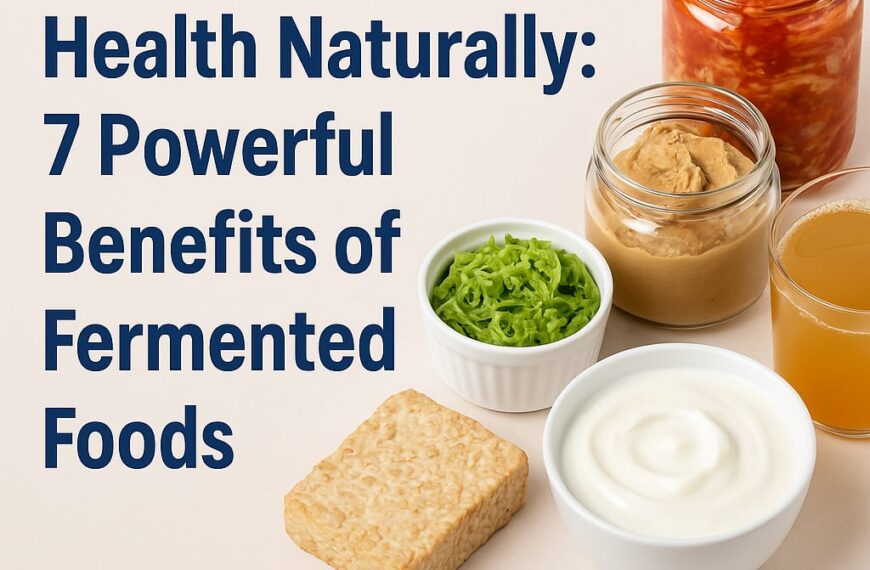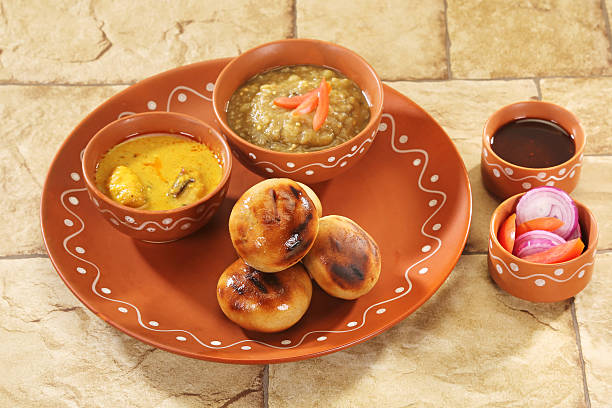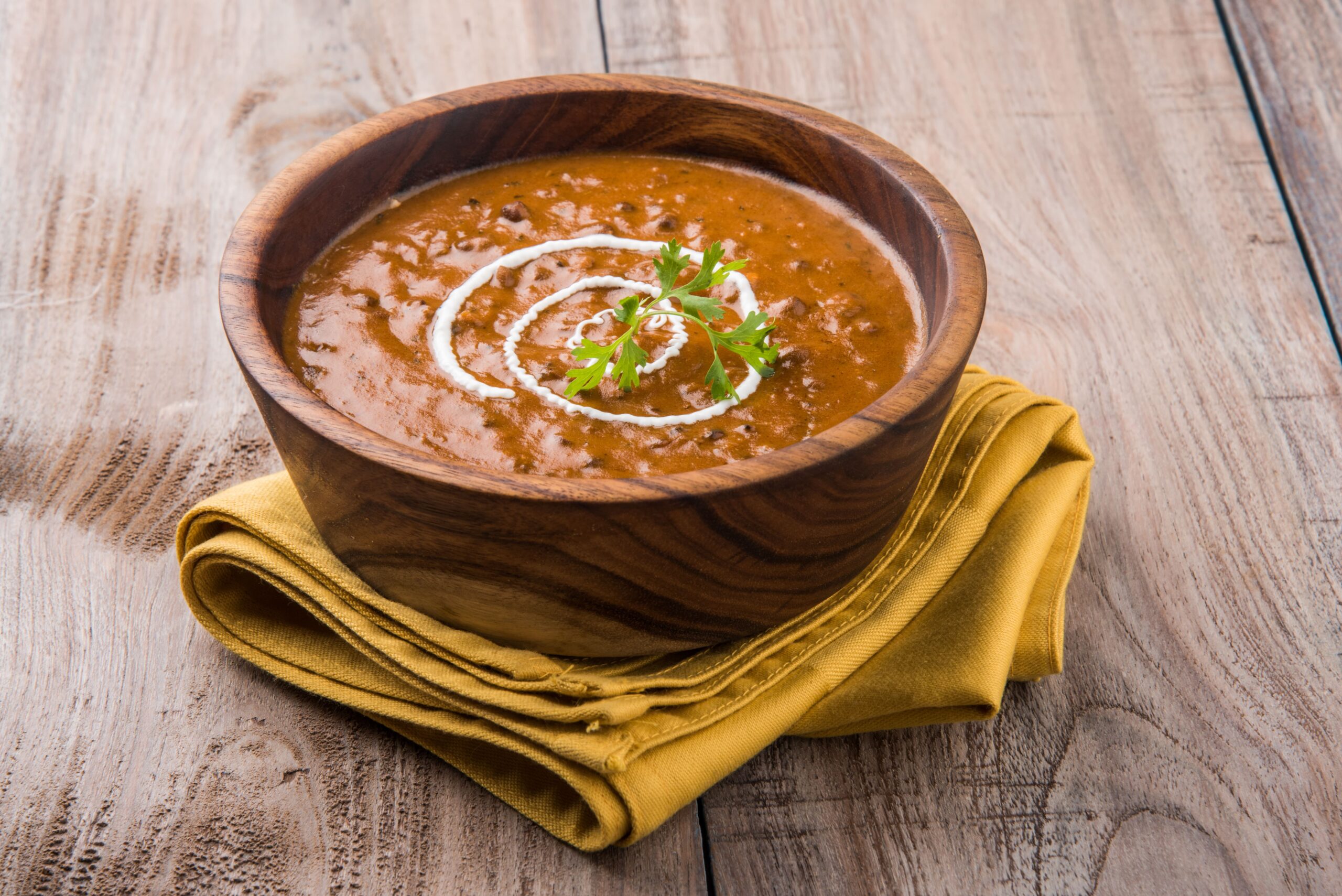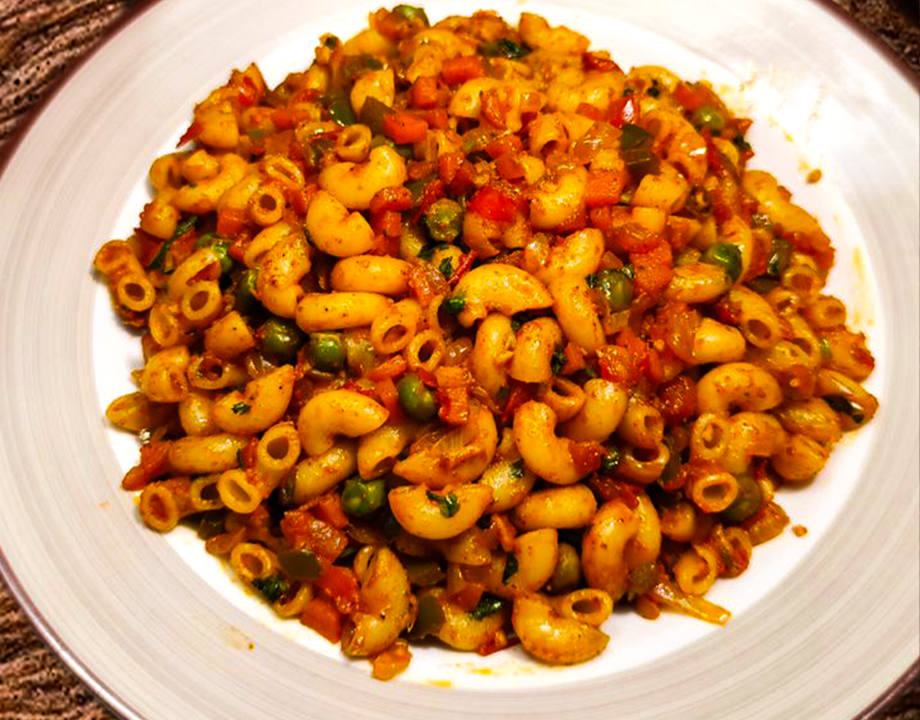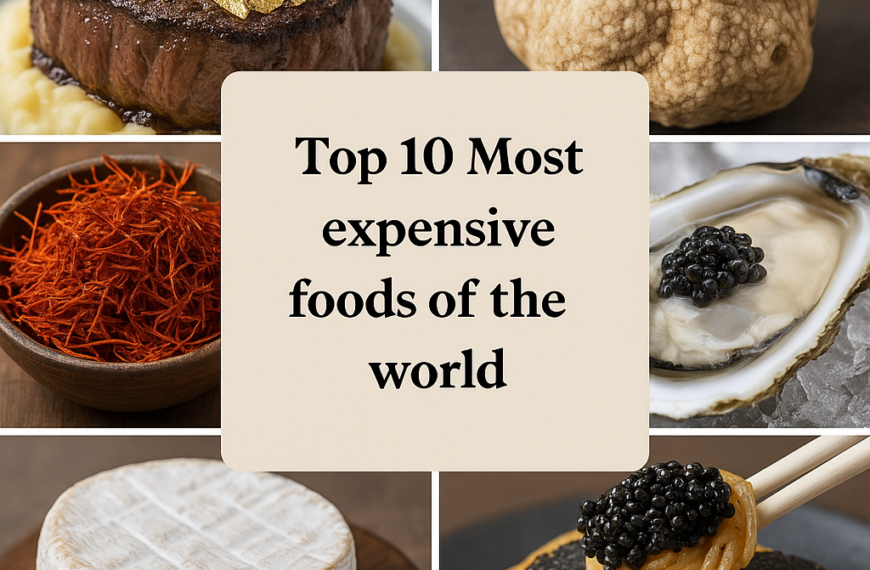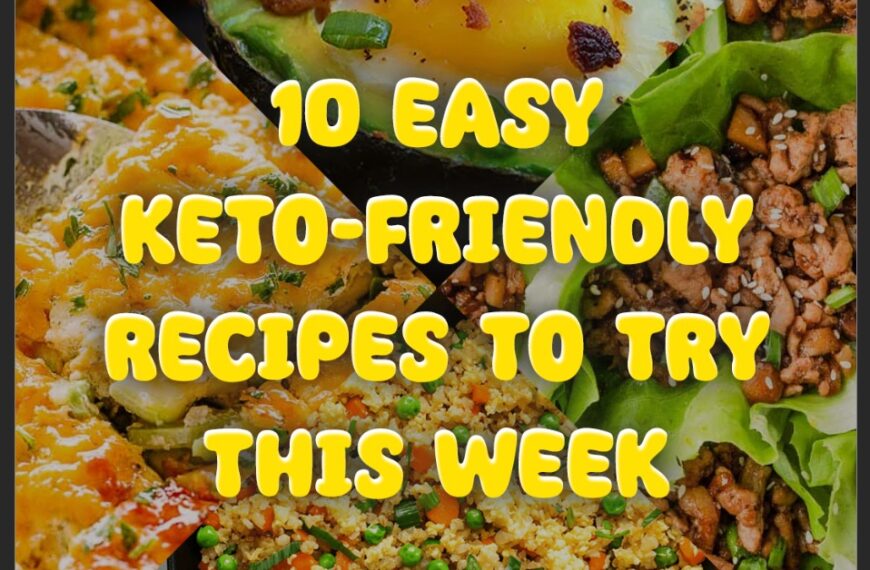In This Article
In the world of health and nutrition, one of the most persistent myths is that vegetarian diets lack sufficient protein. While it’s true that meat and dairy are rich protein sources, the plant kingdom offers an impressive array of high-protein options that are both satisfying and nutritious. For vegetarians and anyone looking to reduce their meat intake without compromising on fullness or energy levels, this article explores a wide range of high-protein vegetarian meals that actually fill you up.
Why High-Protein Vegetarian Meals Are a Better Choice?
1. Cleaner Protein Sources
Less saturated fat than many animal proteins, especially red meat.
Rich in fiber, vitamins, and minerals that meat-based high-protein meals usually lack.
Sources like lentils, tofu, chickpeas, quinoa, and tempeh provide protein plus extra nutrients.
2. Lower Environmental Impact
Plant-based proteins use less land, water, and energy than meat.
Producing lentils, beans, or soy emits far fewer greenhouse gases than livestock farming.
Choosing plant protein is a sustainable move without sacrificing nutritional value.
3. Heart Health Boost
Diets high in plant proteins are linked to lower cholesterol, blood pressure, and heart disease risk.
Fiber-rich foods help regulate blood sugar and reduce inflammation—both critical for long-term health.
4. Muscle Building & Maintenance
Contrary to myths, you can build muscle just as effectively on a high-protein vegetarian diet.
Combining different plant sources (e.g., beans and rice) ensures all essential amino acids are covered.
Great for athletes, gym-goers, or anyone looking to tone up without relying on meat.
5. Mental & Emotional Wellbeing
Some studies suggest plant-heavy diets are linked to lower rates of depression and anxiety.
Less consumption of processed meats leads to fewer inflammatory responses in the body and brain.
6. Versatility & Creativity in the Kitchen
Opens the door to global cuisines like Indian dals, Mediterranean bowls, and Thai tofu curries.
Encourages using whole, colorful, and nutrient-rich foods, keeping meals exciting and diverse.
7. Budget-Friendly
Beans, lentils, tofu, eggs, and nuts are cheaper than most meat or fish.
Buying in bulk and cooking at home means big savings while still hitting protein goals.
Understanding Plant-Based Protein
Before diving into meal ideas, it’s important to understand what makes a plant-based meal high in protein. Proteins are made up of amino acids, and a “complete protein” contains all nine essential amino acids. Many plant sources lack one or more of these, but by combining different plant foods, you can create a complete amino acid profile.
Key high-protein vegetarian ingredients include:
- Lentils
- Chickpeas
- Quinoa
- Tofu and Tempeh
- Edamame
- Greek Yogurt
- Cottage Cheese (Paneer)
- Chia Seeds
- Hemp Seeds
- Black Beans
- Peas
- Nuts and Nut Butters
- Seitan
To build meals that keep you full, focus on combining protein with fiber and healthy fats. This trio helps regulate blood sugar, sustain energy, and curb hunger for longer periods.
1. Lentil and Vegetable Stew
Protein per serving: 18-20g
Lentils are among the most protein-dense legumes, making them a staple in any vegetarian high-protein diet. One of the most comforting and nourishing ways to enjoy lentils is in a hearty stew. A lentil stew made with carrots, potatoes, spinach, and tomatoes isn’t just a cozy bowl of comfort food—it’s a nutritional powerhouse. Lentils alone provide around 18 grams of protein per cooked cup, and when combined with fiber-rich vegetables like carrots and potatoes, you’re looking at a meal that keeps you full for hours.
Spinach adds a dose of iron and calcium, while tomatoes bring in antioxidants like lycopene. This dish is not only rich in protein, but also packed with essential vitamins and minerals that support overall health, including B vitamins, magnesium, and zinc. Plus, thanks to the combination of fiber, slow-digesting carbs, and protein, it helps stabilize blood sugar and prevent energy crashes. You can easily customize this stew by adding other protein boosters like quinoa, barley, or even a dollop of Greek yogurt on top. It’s a one-pot meal that’s easy to batch cook and gets even better the next day, making it perfect for meal prep.
Ingredients:
- 1 cup brown lentils
- 2 carrots, diced
- 2 potatoes, cubed
- 1 cup spinach
- 1 onion, chopped
- 2 cloves garlic, minced
- 4 cups vegetable broth
- Olive oil, salt, pepper, and herbs like thyme or bay leaf
Instructions:
- Sauté onions and garlic in olive oil until fragrant.
- Add carrots and potatoes and cook for 5 minutes.
- Stir in lentils and broth. Simmer for 30-40 minutes until lentils are soft.
- Add spinach and seasonings, cook for 5 more minutes.
Tip: Add quinoa or barley for an extra protein and fiber boost.
2. Chickpea and Quinoa Salad
Protein per serving: 22g
This colorful and crunchy salad is a perfect example of how plant-based ingredients can come together to form a high-protein, satisfying, and delicious meal. Chickpeas and quinoa are the stars of the show here, both known for their impressive protein content and nutrient density. Chickpeas (also known as garbanzo beans) provide about 15 grams of protein per cooked cup, along with a hefty dose of dietary fiber, iron, magnesium, and folate. Quinoa, a gluten-free ancient grain, adds another 8 grams of complete protein per cup and is one of the few plant foods that contains all nine essential amino acids.
The salad is brought to life with the addition of fresh vegetables like cucumbers, tomatoes, and bell peppers, which not only add crunch and color but also boost hydration and supply antioxidants like vitamin C and beta-carotene. A sprinkle of fresh herbs like parsley or mint adds freshness and depth of flavor, while the creamy tahini lemon dressing ties everything together with a tangy, nutty finish. Tahini, made from ground sesame seeds, also contributes a modest amount of protein and healthy fats that help with nutrient absorption and satiety.
Ingredients:
- 1 cup cooked quinoa
- 1 can chickpeas (drained and rinsed)
- 1 cucumber, diced
- 1 tomato, diced
- 1 bell pepper, chopped
- Fresh parsley or mint
- Dressing: 2 tbsp tahini, 1 tbsp lemon juice, 1 clove garlic (minced), salt, and water to thin
Instructions:
- Mix all vegetables and chickpeas in a bowl.
- Stir in quinoa and herbs.
- Drizzle with dressing and mix well.
Why it works: Chickpeas and quinoa both contain high amounts of protein, and quinoa is a complete protein by itself.
3. Tofu Stir Fry with Brown Rice
Protein per serving: 25g
Tofu is a powerhouse of plant-based protein, derived from soybeans, and offers around 10 grams of protein per half-cup serving. It’s also rich in calcium, iron, and contains all nine essential amino acids, making it a complete protein source — a rare find in the plant kingdom. What makes tofu especially appealing in cooking is its remarkable ability to absorb the flavors of the ingredients and sauces it’s cooked with, acting as a blank canvas for culinary creativity.
In this dish, tofu is stir-fried with a colorful mix of vegetables like broccoli, bell peppers, carrots, and snap peas, making it a vibrant, nutrient-dense meal. These veggies not only bring crunch and color but also contribute essential vitamins, antioxidants, and dietary fiber, enhancing both the flavor and the satiety factor.
The stir fry is lightly seasoned with soy sauce and sesame oil, creating a savory umami profile with a hint of nuttiness. Pairing it with brown rice adds a chewy texture and extra fiber, which helps slow digestion and keeps you feeling full for longer.
Ingredients:
- 1 block firm tofu, cubed and pressed
- 2 cups mixed vegetables
- 1 tbsp soy sauce
- 1 tsp sesame oil
- 1 tsp cornstarch (optional for crispiness)
- 1 cup cooked brown rice
Instructions:
- Sauté tofu until golden. Remove and keep aside.
- Stir fry veggies, then add tofu back with soy sauce and sesame oil.
- Serve over brown rice.
Protein Boost Tip: Use edamame and sesame seeds as garnish.
4. Black Bean Tacos with Avocado and Salsa
Protein per serving: 17g
Black beans are one of the most nutrient-dense legumes, boasting around 15 grams of protein per cooked cup. They are also an excellent source of dietary fiber, complex carbohydrates, and essential minerals like iron, magnesium, and folate. Thanks to their high fiber and protein content, black beans provide long-lasting energy and keep you full for hours, making them a great centerpiece for vegetarian meals.
These tacos combine seasoned black beans with creamy avocado, fresh salsa, and a crunchy cabbage slaw, all nestled in whole grain taco shells. The textures and flavors work beautifully together — the beans provide heartiness, the avocado adds healthy fats and creaminess, the salsa delivers brightness, and the slaw gives a refreshing crunch.
Ingredients:
- 1 cup cooked black beans
- 1 avocado, mashed
- 1/2 cup salsa
- Shredded cabbage or lettuce
- Whole wheat taco shells
- Optional: cheese or vegan cheese
Instructions:
- Warm taco shells.
- Heat and season black beans (salt, cumin, chili powder).
- Mash avocado with a pinch of salt (add lime if desired).
- Assemble: avocado → beans → salsa → cabbage → cheese (optional).
- Serve & enjoy!
Bonus: Add a sprinkle of cheese or vegan cheese for extra protein.
5. Paneer Bhurji (Scrambled Cottage Cheese)
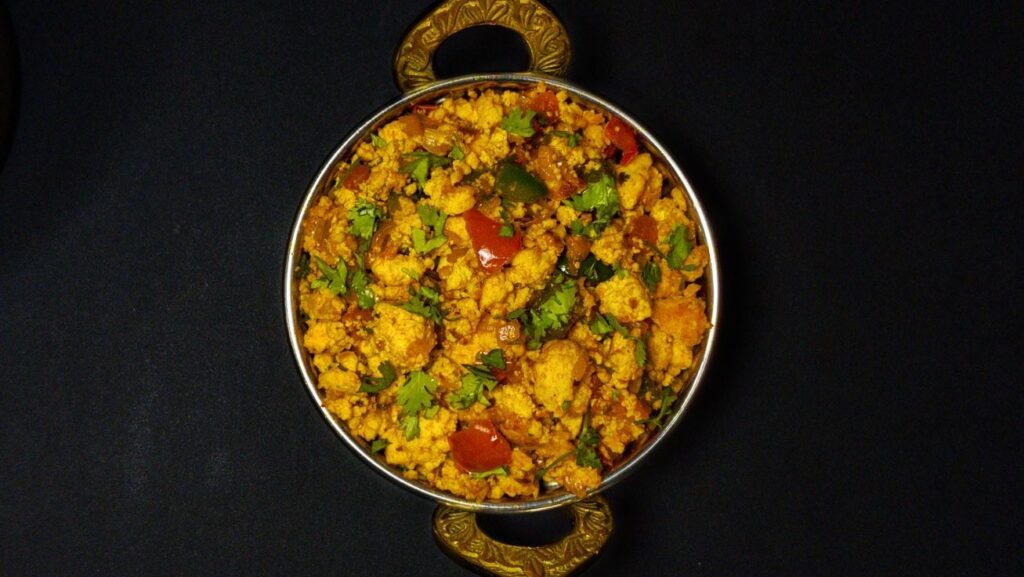
Protein per serving: 28g
Paneer, also known as Indian cottage cheese, is one of the richest vegetarian sources of protein, especially for those who consume dairy. Made by curdling milk with an acidic agent like lemon juice or vinegar, paneer is high in casein protein and offers a generous amount of calcium and phosphorus, important for bone health. Unlike many cheeses, paneer is non-melting and holds its shape when cooked, making it ideal for Indian stir-fry style dishes like Paneer Bhurji.
This dish is a popular North Indian recipe and resembles scrambled eggs in texture and preparation. Crumbled paneer is sautéed with aromatic spices, onions, tomatoes, and green chilies, making it flavorful, protein-packed, and extremely satisfying.
Ingredients:
- 200g paneer, crumbled
- 1 onion, chopped
- 1 tomato, chopped
- 1 green chili, minced
- Spices: turmeric, cumin, garam masala
Instructions:
- Sauté onions and chilies.
- Add tomatoes and spices, cook until soft.
- Mix in paneer and cook for 5 minutes.
Serve with: Whole wheat roti or multigrain toast for added fiber.
6. Greek Yogurt Parfait with Chia and Berries
Protein per serving: 20g
Greek yogurt is a standout among vegetarian protein sources, offering nearly double the protein of regular yogurt thanks to its straining process, which removes excess whey and results in a thicker, creamier texture. Especially in its non-fat or low-fat forms, Greek yogurt can deliver 15–20 grams of protein per serving, making it an excellent choice for breakfast, snacks, or even dessert.
Pairing Greek yogurt with superfoods like chia seeds and fresh berries not only boosts its nutritional profile but also enhances satiety. Chia seeds are rich in fiber, omega-3 fatty acids, and plant-based protein, while berries are loaded with antioxidants, vitamins, and natural sweetness. A sprinkle of granola adds crunch and complex carbs to keep you fueled.
Ingredients:
- 1 cup Greek yogurt
- 1 tbsp chia seeds
- ½ cup mixed berries
- Granola (for crunch)
- Optional: scoop of protein powder
Instructions:
- Layer Greek yogurt, chia seeds, and berries in a glass or bowl.
- Top with granola for crunch.
- Optional: Mix in protein powder for extra gains.
- Chill or enjoy immediately!
Why it’s filling: The combination of protein, fiber, and healthy fats keeps you full for hours.
Bonus Tip: Add a scoop of protein powder for a post-workout meal.
7. Tempeh Stir Fry with Buckwheat Noodles
Protein per serving: 30g
Tempeh is a powerhouse of plant-based nutrition. Made from fermented soybeans, it not only offers a firm, hearty texture but also packs more protein than tofu — around 19–21 grams per 100g serving. The fermentation process enhances digestibility and boosts gut-friendly probiotics, making tempeh both nourishing and satisfying. Its nutty, slightly earthy flavor pairs beautifully with Asian-inspired ingredients.
In this dish, pan-seared tempeh is combined with soba noodles (made from buckwheat, a gluten-free whole grain high in fiber and protein) and colorful vegetables like carrots, bell peppers, and bok choy. The combination results in a balanced, umami-rich bowl full of flavor, texture, and nutrition.
Ingredients:
- 1 block tempeh
- 2 cups stir fry vegetables
- 1 tbsp soy sauce
- 1 tsp maple syrup
- Buckwheat noodles, cooked
Instructions:
- Pan-fry cubed tempeh until golden.
- Add veggies & stir-fry for 3–5 mins.
- Stir in soy sauce + maple syrup.
- Toss in cooked buckwheat noodles, mix well.
- Serve warm & enjoy that plant-powered goodness!
Pro Tip: Marinate tempeh in soy sauce, garlic, and maple syrup before frying.
8. Hemp Seed Smoothie
Protein per serving: 18-20g
Hemp seeds are a small but mighty superfood, especially beneficial in a vegetarian or plant-based diet. Just 2 tablespoons of hemp seeds provide around 10 grams of complete protein, meaning they contain all nine essential amino acids — a rare quality among plant sources.
Ingredients:
- 2 tbsp hemp seeds
- 1 banana
- 1 tbsp peanut butter
- 1 cup almond milk
- Handful of spinach
- Optional: protein powder or ice cubes
Instructions:
- Toss all ingredients into a blender.
- Blend until smooth and creamy.
- Sip & feel strong — perfect post-workout or breakfast fuel.
They’re also loaded with:
- Omega-3 and Omega-6 fatty acids in an ideal 3:1 ratio, supporting brain and heart health.
- Magnesium, zinc, and iron, which aid in energy production, immunity, and oxygen transport.
- Fiber, especially when unhulled, helping in digestion and satiety.
In smoothies, hemp seeds blend in easily without affecting the flavor too much, but they add a creamy texture and a nutty undertone. Including them in your almond milk, banana, spinach, and peanut butter smoothie gives it a nutrient-dense boost, making it a perfect post-workout meal or a filling breakfast.
Why hemp seeds? They’re a complete protein and also rich in omega-3s.
Extra Boost: Add oats or flaxseeds for more fiber and slow-digesting carbs.
9. Seitan Stir Fry with Veggies
Protein per serving: 35g
Seitan, often dubbed “wheat meat,” is made from gluten—the main protein found in wheat—and is one of the most protein-rich vegetarian foods available. A 100g serving of seitan packs around 25 grams of protein, making it a top choice for anyone looking to significantly boost their intake without animal products.
What makes seitan especially appealing is its dense, chewy, and meat-like texture, which closely mimics chicken or beef when cooked. It absorbs marinades and sauces well, allowing for endless flavor possibilities. When stir-fried with colorful vegetables like bell peppers, broccoli, carrots, and snap peas, seitan creates a savory, satisfying dish that’s rich in protein, fiber, and essential nutrients.
Ingredients:
- 1 cup seitan, sliced
- Mixed veggies
- Soy sauce, garlic, ginger
- Serve with brown rice or quinoa
Instructions:
- Sear sliced seitan in a hot pan with sesame oil until golden.
- Add veggies, stir-fry for 3–5 mins.
- Splash in soy sauce & ginger, toss to coat.
- Serve as is or over brown rice/quinoa.
Meal Tip: Seitan is best when grilled or sautéed with bold spices.
10. Eggplant and Chickpea Curry
Protein per serving: 20g
This hearty, spicy curry is a comforting and protein-rich meal that brings together the creaminess of eggplant and the earthiness of chickpeas. Eggplant acts like a sponge, soaking up the vibrant flavors of spices and aromatics, while chickpeas add bulk, texture, and a solid dose of plant-based protein and fiber.
Ingredients:
- 1 eggplant (cubed)
- 1 can chickpeas (drained)
- 1 cup crushed tomatoes
- 1 onion + 2 garlic cloves (minced)
- 1 tbsp curry powder
- Optional: 2 tbsp Greek yogurt (for creaminess & protein)
Instructions:
- Sauté onion & garlic until fragrant.
- Add eggplant, cook until soft.
- Stir in chickpeas, tomatoes, and curry powder.
- Simmer for 15–20 mins. Stir in Greek yogurt if using.
- Serve with rice or naan.
Add-ins: Stir in some Greek yogurt for creaminess and extra protein.
11. Baked Sweet Potato with Black Beans and Avocado
Protein per serving: 16g
This colorful and comforting dish is a powerhouse of nutrients and flavors. Baked sweet potatoes serve as a naturally sweet and fiber-rich base, while black beans add a hearty dose of plant-based protein and fiber that helps keep you full. The creamy mashed avocado or guacamole on top provides healthy fats and essential nutrients like potassium and vitamin E.
Ingredients:
- 1 baked sweet potato
- ½ cup black beans (seasoned)
- ½ avocado (mashed or sliced)
- Optional toppings: salsa, corn, jalapeños, cheese
Instructions:
- Bake sweet potato at 400°F (200°C) for ~45 mins.
- Warm and season black beans.
- Slice open potato, stuff with beans + avocado.
- Add toppings like salsa, corn, cheese, or jalapeños.
Meal Upgrade:
Turn it into a bowl with quinoa + kale!
Why it rocks:
Sweet + savory + spicy — fiber, protein, and healthy fats in one cozy dish.
12. Vegetarian Chili
Protein per serving: 22g
This hearty and comforting vegetarian chili is a true high-protein, high-fiber powerhouse, perfect for a cozy night in or a meal prep staple. It’s loaded with kidney beans, black beans, lentils, bell peppers, corn, tomatoes, and a bold mix of spices that give it a rich, smoky flavor.
Ingredients:
- 1 cup mixed beans (kidney, black, lentils)
- 1 bell pepper (chopped)
- ½ cup corn
- 1 cup diced tomatoes
- 1 onion + 2 garlic cloves
- Chili powder, cumin, smoked paprika
- Optional: avocado, Greek yogurt, brown rice
Quick Steps:
- Sauté onion + garlic.
- Add peppers, beans, corn, tomatoes + spices.
- Simmer 20–25 mins until thick and flavorful.
- Serve with brown rice or whole wheat bread.
- Top with avocado or Greek yogurt!
Serve with: Brown rice or whole wheat bread. Top with avocado or Greek yogurt.
Tips for Boosting Protein in Vegetarian Meals
- Add seeds and nuts: Chia, flax, hemp, sunflower seeds, and almonds are great additions.
- Go whole grain: Opt for quinoa, buckwheat, millet, and brown rice.
- Use legumes: Beans, lentils, and peas are versatile and protein-rich.
- Incorporate dairy or dairy alternatives: Greek yogurt, paneer, and fortified soy milk.
- Try meat substitutes: Seitan, tempeh, and tofu are excellent meat alternatives.
- Snack smartly: Choose roasted chickpeas, trail mix, or protein bars with clean ingredients.
- Use protein-rich flours: Like chickpea flour (besan), which is perfect for savory pancakes and fritters.
Conclusion
Eating high-protein vegetarian meals doesn’t mean sacrificing flavor or satiety. With the right ingredients and thoughtful preparation, you can enjoy a wide variety of dishes that keep you full, energized, and nutritionally balanced. Whether you’re a lifelong vegetarian or simply looking to diversify your diet, these protein-packed meals are sure to satisfy your hunger and support your health goals.
Incorporate these meals into your weekly plan, experiment with spices and textures, and watch how satisfying a vegetarian lifestyle can truly be. After all, a well-fed body fuels a well-lived life. And remember, protein isn’t just about muscle building—it’s vital for hair, skin, hormones, and even brain health.
So go ahead, plate up that tofu stir-fry or blend a hemp seed smoothie. Your body (and taste buds) will thank you.

